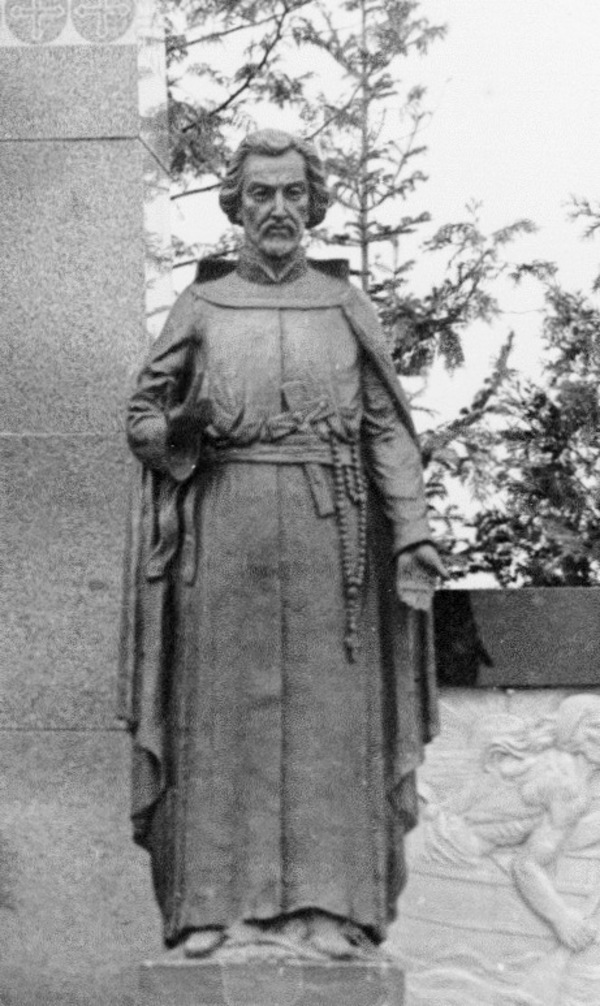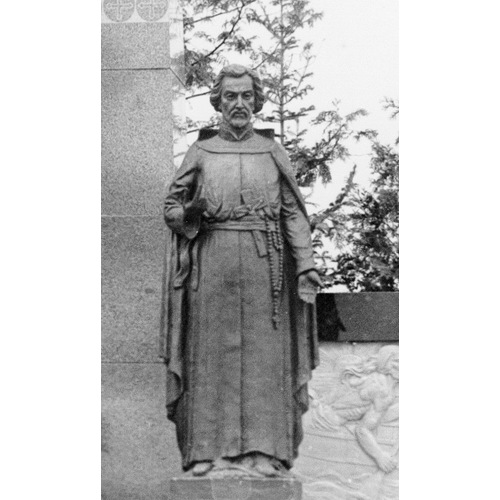
Source: Courtesy of Wikimedia Commons
QUEN, JEAN DE, priest, Jesuit, missionary, discoverer of Lac Saint-Jean, founder of the Saguenay missions, superior of the missions of the Jesuits of New France, annalist; b. May 1603 (al. 1600, 1604) at Amiens (Picardy); d. 8 Oct. 1659 at Quebec.
Jean de Quen entered the Society of Jesus 13 Sept. 1620. After his noviciate, three years of philosophy in Paris, one year as a regent and three years of theology at Clermont, one year as a regent at Amiens, and his third probationary year in Belgium, he taught for three years at the Collège in Eu, and then left for Canada. He arrived at Quebec 17 Aug. 1635.
He was first employed as a teacher at the college in Quebec, which opened its doors in 1635; he soon went to the fixed mission at Sillery, and returned to Quebec, where he was responsible for ministering to the parish of Notre-Dame-de-la-Recouvrance. In 1640 he went back to Sillery, and concerned himself more particularly with the hospital. There he wore himself down to the danger point; he recovered fairly quickly, and was sent to the Trois-Rivières residence; he thereby had the opportunity to bring about many conversions. He returned the following year to Sillery, and was in charge of that important mission centre for eight years (1642–49). He fulfilled a very active ministry there, which brought him into contact with Indians from almost everywhere, more particularly the Montagnais, whose language he learned perfectly.
In the spring of 1642 Jean de Quen was entrusted with the Montagnais mission, with which he concerned himself for 11 years. This mission had been founded the preceding year at Tadoussac, where between spring and the end of August the fur trade brought Indians from all parts of the vast territory of the Saguenay, from the great Lac Mistassini in the interior to the Sept-Îles, on the shore of the St. Lawrence estuary. Some also came from the south shore and from the Gaspé peninsula. Father de Quen was well prepared for this diversity of types, and was highly esteemed by the Montagnais; with the aid of Fathers Jacques Buteux, Gabriel Druillettes, Martin de Lyonne, and Charles Albanel, following one upon another, he created a form of summer mission suited to the existence of these nomadic peoples, and made a success of it. He formed a solid nucleus of Christians who helped him to reach the most distant groups. (It was at Tadoussac that the first stone church in Canada was constructed, in 1646.)
During the summer of 1647, having learned that some neophytes on their way to the mission had been halted at Lac Piékouagami (Saint-Jean) by illness, he got two young Montagnais to take him there, and covered in five days a distance of 120 miles, with ten portages to slow his progress. During this journey he discovered Lac Saint-Jean and the route leading into the interior of the Saguenay, which the Indians had kept a secret from the white men. He arrived at the lake via the Belle-Rivière on 16 July. “This lake is so large,” wrote Father de Quen, “that one hardly sees its banks; it seems to be round in shape. It is deep and very full of fish; they fish here for pike, perch, salmon, trout, dories, white-fish, carp, and many other kinds. It is surrounded by a flat country, terminating in high mountains, distant 3, four or five leagues from its shores. It is fed by the waters of fifteen rivers, or thereabout, which serve as highways for the small nations which are back in the country, to come to fish in this lake, and to maintain the intercourse and friendship which they have among themselves.”
Crossing a part of the lake, he went to visit the Indians of the Porcupine nation at the mouth of the Rivière Métabetchouan, the meeting-place of the tribes from the interior of the Saguenay.
Father de Quen returned there in 1650 and again in 1652, on the latter occasion for a twelve-day mission that was subsequently to be repeated regularly. In 1651 and 1652 he did the same for the Oumamiwek (Bersamite) nation, a small tribe on the coast in the direction of the Sept-Îles, more than 300 miles from Tadoussac. One may therefore consider Father de Quen as the founder of the Saguenay missions.
Apart from the few months that these missions required annually, Jean de Quen concerned himself actively with his ministry at Sillery and Quebec, and in the vicinity (Beaupré shore, Île d’Orléans, etc.). In 1656 he was appointed superior of the missions in New France, a post which he occupied until 8 Sept. 1659, a month before his death. It was during his term of office that, with the arrival of Abbé de Queylus [see Thubières] as vicar general, the crisis over ecclesiastical jurisdiction in New France came to a head.
Father de Quen is the author of the Relations des Jésuites for the year 1655–56, and of the Journal des Jésuites from 25 Oct. 1656 to 7 Sept. 1659 (except during a few brief absences). He collaborated in the “Catalogue des bienfaicteurs de N. Dame de Recouvrance (1632–57).” He is also said to have undertaken correspondence in order to refute the accusations levelled against the Jesuits on the subject of the fur trade. The Relations several times mention his letters and quote certain passages from them. Here is one that illustrates his style of writing: “I sent to the hospital that good old man, Adam, the most aged of the savages. I rescued him from the death which these Barbarians intended to cause him by a rope, in order to rid themselves of a burden that greatly oppressed them. I begged our Frenchmen who were going down there to take him in their bark: I do not doubt that the Mothers will receive him willingly; they have already fed and aided him, during the whole of last winter. This worthy man has no other malady than that which he began to contract more than a hundred years ago.”
Father de Quen, who had always given particular attention to the care of the sick, was finally a victim of his own devotion. The Journal des Jésuites recounts the event in this way, in October 1659: “On the 1st, Jean de Quen took to his bed; and on the 8th. he died from those contagious fevers that had been brought by the last ship. . . . Father de Quen was buried on the morning of the 9th.” He had given Canada 24 years of untiring and fruitful activity.
His remains (and those of Jesuits Du Peron and Liégeois) were uncovered in 1878 under the chapel of the Collège des Jésuites after it was demolished. They were placed temporarily in the Belmont cemetery, and were buried solemnly in a vault under the chapel of the Quebec Ursulines on 12 May 1891. The historical record of these facts, composed by C.-E. Rouleau, contains a brief biographical notice of Jean de Quen, the only one that has ever been published.
ACSM, “Mémoires touchant la mort et les vertus des pères Isaac Jogues . . .” (Ragueneau), repr. APQ Rapport, 1924–25, 40f., 47–49, Lettres du P. Jean de Quen. ASQ, mss, 43, “Étude sur les Relations des Jésuites,” par Félix Martin; Polygraphie, XIII, 22. Marie Guyart de l’Incarnation, Lettres (Richaudeau), I, 137–40, 208, JR (Thwaites), XX, 238; XXXI, 248–54; XLII, 9–262, 268–88; LXXI, 123; et passim. JJ (Laverdière et Casgrain), 199–263, 266; et passim. Lanctot, Histoire du Canada, I, 285–87. L’histoire du Saguenay: depuis l’origine jusqu’à 1870 (Soc. hist. du Saguenay pub., III, Chicoutimi, 1938). “Le Père Jean de Quen,” BRH, XIX (1913), 256. Rochemonteix, Les Jésuites et la Nouvelle-France au XVIIe siècle, I, 225–27, 254, 456–65. C.-E. Rouleau, Découverte des restes de trois missionnaires de la Compagnie de Jésus (Québec, 1893).
Cite This Article
Victor Tremblay, “QUEN, JEAN DE,” in Dictionary of Canadian Biography, vol. 1, University of Toronto/Université Laval, 2003–, accessed April 12, 2025, https://www.biographi.ca/en/bio/quen_jean_de_1E.html.
The citation above shows the format for footnotes and endnotes according to the Chicago manual of style (16th edition). Information to be used in other citation formats:
| Permalink: | https://www.biographi.ca/en/bio/quen_jean_de_1E.html |
| Author of Article: | Victor Tremblay |
| Title of Article: | QUEN, JEAN DE |
| Publication Name: | Dictionary of Canadian Biography, vol. 1 |
| Publisher: | University of Toronto/Université Laval |
| Year of publication: | 1966 |
| Year of revision: | 1979 |
| Access Date: | April 12, 2025 |



